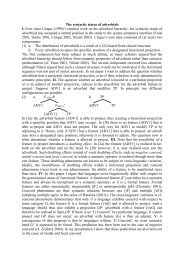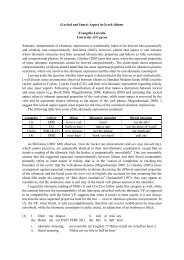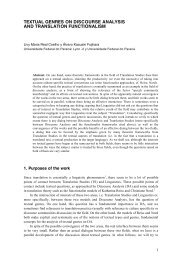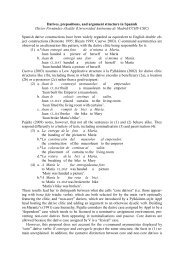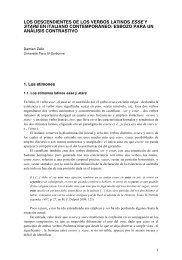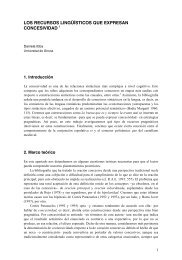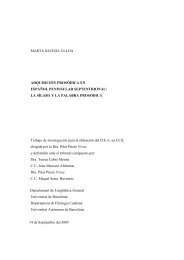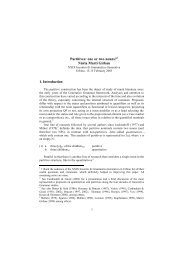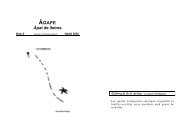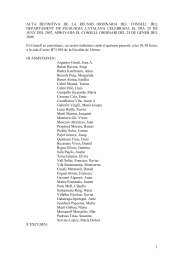Prefixation in English and Catalan - Departament de Filologia ...
Prefixation in English and Catalan - Departament de Filologia ...
Prefixation in English and Catalan - Departament de Filologia ...
Create successful ePaper yourself
Turn your PDF publications into a flip-book with our unique Google optimized e-Paper software.
may be consi<strong>de</strong>red negative by some, <strong>and</strong> can expla<strong>in</strong> the observed <strong>de</strong>pen<strong>de</strong>ncies<br />
between prefixes like a-, <strong>de</strong>s-, en- <strong>and</strong> the suffix –miento <strong>in</strong> Spanish, or the prefixes en-,<br />
be- <strong>and</strong> the suffix –ment <strong>in</strong> <strong>English</strong> (cf. e.g. Alcoba [<strong>in</strong> Varela (1993)] <strong>and</strong> Williams<br />
(1981a) respectively), it faces some problems. Hav<strong>in</strong>g a circumfix would imply ternary<br />
branch<strong>in</strong>g, an option that would be very marked <strong>in</strong> morphology, if it exists at all. This<br />
untenable structure would be an exception to the general pr<strong>in</strong>ciple of b<strong>in</strong>ary branch<strong>in</strong>g,<br />
embodied <strong>in</strong> Aronoff’s (1976) B<strong>in</strong>ary Branch<strong>in</strong>g Hypothesis (BBH), accord<strong>in</strong>g to which<br />
one affix is ad<strong>de</strong>d at a time, result<strong>in</strong>g <strong>in</strong> morphological trees branch<strong>in</strong>g <strong>in</strong> a b<strong>in</strong>ary<br />
fashion (see e.g. Cabré (1994) <strong>and</strong> Drijkon<strong>in</strong>gen’s (1999) <strong>de</strong>fence of the BBH).<br />
2.4.2.2 Two constituents<br />
A second alternative would be the structure [prefix [x]], which has been proposed for<br />
languages whose <strong>in</strong>flectional paradigm does not conta<strong>in</strong> (at least visibly) the thematic<br />
vowel. In this structure the prefix would be category-chang<strong>in</strong>g. Although it would be an<br />
exception to the generalization that prefixes do not change category, at the same time it<br />
would expla<strong>in</strong> the fact that en-, be<strong>in</strong>g a head, is able to potentiate the suffix –ment (cf.<br />
e.g. Siegel (1979), Williams (1981a), Selkirk (1982), 13 Fabb (1984), Gavarró (1990),<br />
Lieber & Baayen (1993)). Concern<strong>in</strong>g the prefix un<strong>de</strong>r analysis, it is generally assumed<br />
that en- subcategorizes for [+N] bases to form Vs (e.g. [em[bitter]A]V, [en[danger]N]V),<br />
thus conform<strong>in</strong>g to the Modified Unitary Base Hypothesis (MUBH) of Aronoff (1976),<br />
accord<strong>in</strong>g to which an affix may be attached only to bases that form a syntactic class<br />
specifiable <strong>in</strong> terms of a s<strong>in</strong>gle syntactic category feature. 14 As <strong>and</strong> Ns share the same<br />
feature specification: [+N]. However, this account leaves unexpla<strong>in</strong>ed words like<br />
en-livenV, en-lightenV or en-closeV, where the prefix en- has been attached to a V. This<br />
clearly goes aga<strong>in</strong>st the MUBH: there is no way to <strong>de</strong>rive a s<strong>in</strong>gle syntactic feature that<br />
<strong>in</strong>clu<strong>de</strong>s As, Ns <strong>and</strong> Vs. In addition, another alternative should be found for <strong>Catalan</strong> as<br />
well as for <strong>English</strong>. Apart from the overt prefix en-, <strong>Catalan</strong> conta<strong>in</strong>s a visible<br />
<strong>in</strong>flectional suffix (cf. 14) <strong>and</strong>, as it will be shown, <strong>English</strong> words like encase conta<strong>in</strong> a<br />
13 Selkirk (1982) regards the small set of <strong>English</strong> category-chang<strong>in</strong>g prefixes (a-, be-, <strong>de</strong>-, en-) as not<br />
exceptions to the Rel. RHR, s<strong>in</strong>ce the prefixes would constitute the rightmost element with<strong>in</strong> the structure<br />
which has such a syntactic category <strong>and</strong> thus would be the head with respect to this feature. However, I<br />
still consi<strong>de</strong>r this small number of prefixes exceptional, given that these would be the only ones that are<br />
able to change the category of the word they attach to.<br />
14 Follow<strong>in</strong>g the <strong>de</strong>composition of the four major lexical categories <strong>in</strong>to the features [+/-N] [+/-V], the<br />
follow<strong>in</strong>g picture is <strong>de</strong>rived: Noun [+N-V], Adjective [+N+V], Verb [-N+V], <strong>and</strong> Preposition [-N-V].<br />
14



